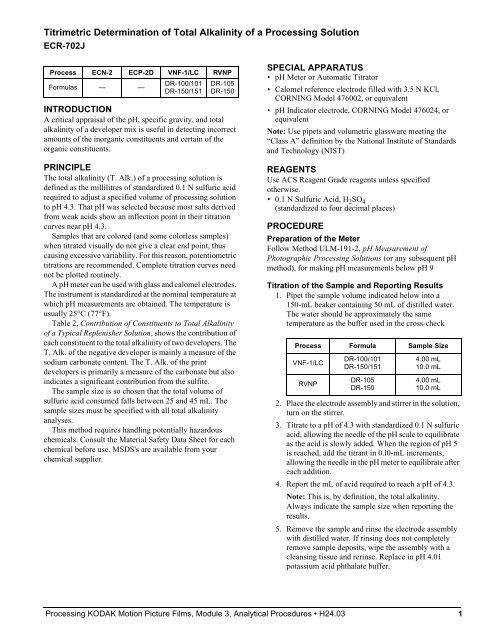Processing kodak motion picture films, module 3 analytical procedures
Processing kodak motion picture films, module 3 analytical procedures
Processing kodak motion picture films, module 3 analytical procedures
You also want an ePaper? Increase the reach of your titles
YUMPU automatically turns print PDFs into web optimized ePapers that Google loves.
Titrimetric Determination of Total Alkalinity of a <strong>Processing</strong> Solution<br />
ECR-702J<br />
Process ECN-2 ECP-2D VNF-1/LC RVNP<br />
Formulas — —<br />
DR-100/101<br />
DR-150/151<br />
DR-105<br />
DR-150<br />
INTRODUCTION<br />
A critical appraisal of the pH, specific gravity, and total<br />
alkalinity of a developer mix is useful in detecting incorrect<br />
amounts of the inorganic constituents and certain of the<br />
organic constituents.<br />
PRINCIPLE<br />
The total alkalinity (T. Alk.) of a processing solution is<br />
defined as the millilitres of standardized 0.1 N sulfuric acid<br />
required to adjust a specified volume of processing solution<br />
to pH 4.3. That pH was selected because most salts derived<br />
from weak acids show an inflection point in their titration<br />
curves near pH 4.3.<br />
Samples that are colored (and some colorless samples)<br />
when titrated visually do not give a clear end point, thus<br />
causing excessive variability. For this reason, potentiometric<br />
titrations are recommended. Complete titration curves need<br />
not be plotted routinely.<br />
A pH meter can be used with glass and calomel electrodes.<br />
The instrument is standardized at the nominal temperature at<br />
which pH measurements are obtained. The temperature is<br />
usually 25°C (77°F).<br />
Table 2, Contribution of Constituents to Total Alkalinity<br />
of a Typical Replenisher Solution, shows the contribution of<br />
each constituent to the total alkalinity of two developers. The<br />
T. Alk. of the negative developer is mainly a measure of the<br />
sodium carbonate content. The T. Alk. of the print<br />
developers is primarily a measure of the carbonate but also<br />
indicates a significant contribution from the sulfite.<br />
The sample size is so chosen that the total volume of<br />
sulfuric acid consumed falls between 25 and 45 mL. The<br />
sample sizes must be specified with all total alkalinity<br />
analyses.<br />
This method requires handling potentially hazardous<br />
chemicals. Consult the Material Safety Data Sheet for each<br />
chemical before use. MSDS's are available from your<br />
chemical supplier.<br />
SPECIAL APPARATUS<br />
pH Meter or Automatic Titrator<br />
Calomel reference electrode filled with 3.5 N KCl,<br />
CORNING Model 476002, or equivalent<br />
pH Indicator electrode, CORNING Model 476024, or<br />
equivalent<br />
Note: Use pipets and volumetric glassware meeting the<br />
“Class A” definition by the National Institute of Standards<br />
and Technology (NIST)<br />
REAGENTS<br />
Use ACS Reagent Grade reagents unless specified<br />
otherwise.<br />
0.1 N Sulfuric Acid, H 2SO 4<br />
(standardized to four decimal places)<br />
PROCEDURE<br />
Preparation of the Meter<br />
Follow Method ULM-191-2, pH Measurement of<br />
Photographic <strong>Processing</strong> Solutions (or any subsequent pH<br />
method), for making pH measurements below pH 9<br />
Titration of the Sample and Reporting Results<br />
1. Pipet the sample volume indicated below into a<br />
150-mL beaker containing 50 mL of distilled water.<br />
The water should be approximately the same<br />
temperature as the buffer used in the cross-check<br />
Process Formula Sample Size<br />
VNF-1/LC<br />
DR-100/101<br />
DR-150/151<br />
4.00 mL<br />
10.0 mL<br />
2. Place the electrode assembly and stirrer in the solution,<br />
turn on the stirrer.<br />
3. Titrate to a pH of 4.3 with standardized 0.1 N sulfuric<br />
acid, allowing the needle of the pH scale to equilibrate<br />
as the acid is slowly added. When the region of pH 5<br />
is reached, add the titrant in 0.l0-mL increments,<br />
allowing the needle in the pH meter to equilibrate after<br />
each addition.<br />
4. Report the mL of acid required to reach a pH of 4.3.<br />
Note: This is, by definition, the total alkalinity.<br />
Always indicate the sample size when reporting the<br />
results.<br />
5. Remove the sample and rinse the electrode assembly<br />
with distilled water. If rinsing does not completely<br />
remove sample deposits, wipe the assembly with a<br />
cleansing tissue and rerinse. Replace in pH 4.01<br />
potassium acid phthalate buffer.<br />
<strong>Processing</strong> KODAK Motion Picture Films, Module 3, Analytical Procedures H24.03 1<br />
RVNP<br />
DR-105<br />
DR-150<br />
4.00 mL<br />
10.0 mL
















